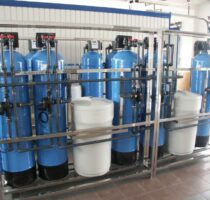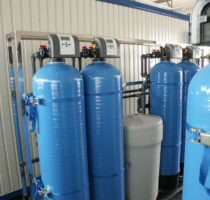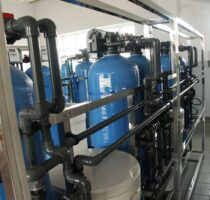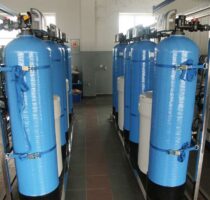AQUATOR – SAFE WATER
The idea behind the AQUATOR system arose from the deterioration of drinking water quality. It concerns securing water quality in crisis situations caused by ecological disasters and failures, as well as the increasing exploitation of the water supply network.
The system can be used to treat water from various sources, such as wells, rivers, lakes, groundwater, and underground water. It can also be used to improve the quality of tap water that is unacceptable due to periodic exceedances of certain permissible values, stabilizing its parameters. It improves taste and odor. The system protects against bacteriological, chemical, and radioactive contamination, guaranteeing the highest quality of drinking water.
It can be applied on any scale – from a single-family house to an apartment building or an entire housing estate. It does not require additional infrastructure, operates automatically, and works in a flow-through mode.
The AQUATOR Water Treatment System is a series of devices designed for use in cases where there is a lack of baseline water quality data or where water quality is variable.
Range of potentially hazardous substances removed (from drinking water).
Standard system:
- Heavy metal cations (such as iron Fe, manganese Mn, copper Cu²⁺, nickel Ni²⁺, lead Pb²⁺, etc., and highly toxic ones such as mercury Hg²⁺, cadmium Cd²⁺, thallium Tl²⁺, arsenic As³⁺, and others).
- Anions such as nitrates NO₃⁻, nitrites NO₂⁻, phosphates PO₄³⁻, chromates CrO₄²⁻, cyanides CN⁻ (including cyanide complexes with metal cations), arsenites AsO₃³⁻ and arsenates AsO₄³⁻, sulfides S²⁻, and many more: both inorganic and organic anions, such as phenolates PhO⁻, anionic detergent anions R-SO₃⁻, etc.
- Harmful and dangerous microorganisms: bacteria, fungi, viruses, algae, protozoa (including Clostridia-type bacteria and Cryptosporidium).
Series of standard devices
- capacity: 1.0 m³/h (nominal) 1.6 m³/h (maximum),
- mechanical filtration system (manually operated filter or replaceable cartridges),
- 3 filters in series, filter diameter: 8” height: 35”,
- UV lamp,
- installation area: 2.5 m²,
- Version for water supply systems only.
- capacity: 2.4 m³/h (nominal) → 3.6 m³/h (maximum),
- mechanical filtration system (manually operated filter or replaceable cartridges),
- 3 filters in series, filter diameter: 12” height: 54”,
- UV lamp,
- installation area: 3.0 m²,
- Version for water supply systems only.
- capacity: 4.0 m³/h (nominal) → 6.4 m³/h (maximum),
- mechanical filtration system (automatic),
- 3 filters in series, filter diameter: 16” height: 65”,
- UV lamp,
- installation area: 5 m².
- capacity: 6.5 m³/h (nominal) → 8.2 m³/h (maximum),
- mechanical filtration system (automatic),
- 3 filters in series, filter diameter: 18” height: 65”,
- UV lamp,
- installation area: 6 m².
- capacity: 9.0 m³/h (nominal) → 14.4 m³/h (maximum),
- mechanical filtration system (automatic),
- 3 filters in series, filter diameter: 24” height: 69”,
- UV lamp,
- installation area: 10 m².
- capacity: 16.0 m³/h (nominal) → 25.6 m³/h (maximum),
- mechanical filtration system (automatic),
- 3 filters in series, filter diameter: 32” height: 72”,
- UV lamp,
- installation area: 15 m².
- capacity: 20.0 m³/h (nominal) → 32.4 m³/h (maximum),
- mechanical filtration system (automatic),
- 3 filters in series, diameter: 36” height: 72”,
- UV lamp,
- installation area: 15 m².
Extended Range of Effectiveness
It is possible to extend the system’s range of effectiveness for special applications. If specific requirements are necessary, the user should specify the contaminants to be eliminated from the treated water. Since we possess extensive knowledge of ion-exchange techniques as well as experience in individual chemical processes, solutions can be applied immediately with a guarantee of full effectiveness.
This applies both to contamination loads and to the source of intake (surface water).
In such cases, we use additional modules designed to perform “special tasks.”
For chemical contamination loads, this may involve an additional filter or filtration system (e.g., cesium removal), or a system of pumps and mechanical filtration in the case of surface water or deep well supply.







